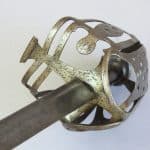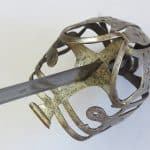
Scottish Basket Hilted Sword by Dru Drury for a Highland Regiment circa 1750 to 1784
To enquire about this itemplease click here
Price: £2,850
Ref: AA.098.23
Item Description
A representative example of a distinctive type of Scottish munitions grade military basket hilted sword dating to the middle to third quarter of the 18th century. These swords were issued to soldiers serving in Scottish Highland infantry regiments such as the 42nd (Black Watch), and are often associated with their service in the French / Indian and Revolutionary Wars in North America. Some swords bear store or rack numbers marked into the pommels and guards, and occasionally amongst these marks the specific regiment can be identified. Most are unmarked. The swords were funded by regimental colonels from their allowances. Anthony D Darling in his “Weapons of the Highland Regiments 1740 to 80” (Historical Arms Series No 33) devotes a section to the background of this sword type.
This hilt type evolved in Scotland towards the mid 18th century as a simplified version of the earlier more usual Scottish basket hilted sword, intended to be cheaper to produce for militias recruited from the Highlands which enforced order in the remote areas. The 43rd, later to become the 42nd , the Black Watch, was first formed for this purpose.
Around 1757 production of these swords transferred to England as demand grew due to the increasing numbers of Highlanders being recruited into the newly raised Highland regiments. England was industrially better placed to fulfill bigger contracts in a more cost-effective and timely manner. Production fell mainly into the hands of two firms, Drury, and Jeffreys. Little is known of the exact process of manufacture, but it is thought that the hilts, blades, scabbards, and grips were sourced from Birmingham, Sheffield and London, then the swords were assembled in workshops in London. Drury and Jeffreys commissioned similar single edged blades, usually between circa 29 inches and 32 inches long, as witnessed on surviving swords, with single fullers. Generally they stamped their blades both sides in a similar manner and size with a crown, “G R” beneath, and their name below.
The hilts are made from thin flattened ribbon-like iron bars mainly cut from plate which are forged together. Between these, primary and secondary guard plates are fixed and pierced with circles and triangles. The pommel is a pronounced cone shape with an integral button on top from which three shallow incised lines radiate downwards. The tops of the three guard arms are secured under a lip which extends around the pommel base.
The grip is often made of spirally grooved wood mounted with a covering of shagreen and bound with brass wire. Some swords, like ours discussed here, have baluster shaped bare wooden grips, and whilst these may be more modern,or even period replacements, due to the frequency with which they occur, they may also be original grip cores. The Highland Regiments gave up their swords in 1784 when production of this sword type had ceased.
The sword discussed retains its black leather stitched scabbard and mounts. Overall, the hilt, blade and scabbard mounts, display a consistent lightly pitted “salt and pepper” patination. The single edged blade has a fuller running underneath the blunt back edge for 80% of its length and is 29.5 inches (75 cm) long. The blade is stamped “DRURY” on both sides in the manner described above. The overall length of the sword is 35.5 inches (90 cm).
For a full discussion of this sword type see Anthony D Darling, Swords for the Highland Regiments 1757 – 1784, Mowbray Incorporated, 1988. For other examples see Cyril Mazansky, British Basket-Hilted Swords, Boydell Press / Royal Armouries, 2005, pages 129 to 130. And John Wallace, Scottish Swords and Dirks, Arms and Armour Press, 1970, fig 42, for a sword now in the National Museums of Scotland, collection reference LA 27.

















